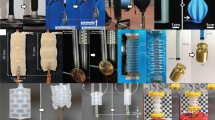Summary
Indirect stimulation of the rat neuromuscular preparation in situ by square-wave and saw-tooth electric current impulses with the frequency of 50–52 cycles/second, 10 msec duration causing submaximal or initial maximal responses gives rise to a peculiar tetanic contraction.
The usual increase of lactic acid in muscle tissue is absent in this contraction: the quantity of inorganic phosphorus in it even decreases compared with the value during the initial condition of rest, while the development of fatigue is retarded as compared to the directly stimulated muscle. The peculiarities of tetanus are connected with increased working capacity of the muscle as a result of the form of activity described above.
Similar content being viewed by others
Literature Cited
I. A. Arshavskii, Uspekhi Sovremennoi Biol. 41, 193–215 (1956).
I. A. Arshavskii and I. I. Gokhblit et al., In the book: Scientific Conference on Problems of Parabiosis, p. 7, Reports of Proceedings. In Russian.
V. A. Belitser, Chemical Transformations in Muscle, Moscow-Leningrad, 1940. In Russian.
I. M. Bocharnikova, The Influence of Carissin and its Phosphorus Derivative on the Working Capacity of Frog Sartorius Nerve-Muscle Preparation During Direct and Indirect Stimulation, Author's Abstract of Candidate's Dissertation, Moscow, 1956. In Russian.
V. M. Vasilevskii, Nervous Regulation of Muscular Activity in Warm-Blooded Animals and Man, Doctoral Dissertation, Kharkov, 1946.
S. N. Kaganovskaia, Biokhimiia 1, No. 4, 479–485 (1936).
M. N. Kondrasheva, Reports of Proceedings of the Conference of the Institute of Pharmacology AMN SSSR, 1953. In Russian.
M. N. Kondrasheva, Biull. Eksptl. Biol. i Med. 1, 40–44 (1954).
M. N. Kondrasheva, Reports of Proceedings of the Conference of the Institute of Pharmacology and Chemotherapy, Moscow, 1956, pp.5–6. In Russian.
A. N. Magnitskii and E. B. Perel'man, Fiziol. Zhur. SSSR 25, 244–247 (1938).
A. N. Magnitskii and V. D. Turbaba, Fiziol. Zhur. SSSR 17, No. 5, 944–949 (1934).
V. S. Misheneva, Author's Abstract of Candidate's Dissertation, Leningrad, 1955. In Russian.
A. I. Rappoport, Fiziol. Zhur. SSSR 17, No. 5, 944–949 (1934).
N. P. Rezviakov, In the book: Advances in the Studies of Reflexes and Physiology of the Nervous System, Moscow-Leningrad, 1925, pp. 47–50. In Russian.
A. A. Ukhtomskii, Collected Works, Leningrad, 1950, vol. 2. In Russian.
O. I. Fainshmidt, Biokhimiia 4, No. 4, 411–422 (1939).
D. L. Ferdman, Biochemistry of Muscle Diseases, Kiev, 1953. In Russian.
V. A. Engel'gardt, Bioch. Z., 1932, v. 261, p. 57.
O. Meyerhof, Die chemische Vorgange im Muskel. Berlin, 1930.
H. Weil-Malherbe and R. H. Green, Biochem. J., 1951, v. 49, p. 286–292.
Author information
Authors and Affiliations
Rights and permissions
About this article
Cite this article
Kondrashova, M.N. Increased work capacity of muscle on stimulation through the nerve and the causes of this phenomenon. Bull Exp Biol Med 46, 806–810 (1958). https://doi.org/10.1007/BF00837792
Received:
Issue Date:
DOI: https://doi.org/10.1007/BF00837792




